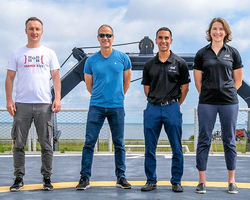Four radio amateurs will head to the International Space Station (ISS) aboard a commercial flight, thanks to Amateur Radio on the International Space Station (ARISS). They are Raja Chari, KI5LIU; Tom Marshburn, KE5HOC; Kayla Barron, KI5LAL, and Matthias Maurer, KI5KFH, a European Space Agency (ESA) astronaut. The targeted launch date is no sooner than October 31, from Kennedy Space Center in Florida. The launch will mark the third SpaceX Crew
 The SpaceX Crew-3 astronauts (L-R) Matthias Maurer, KI5KFH; Thomas Marshburn, KE5HOC; Raja Chari, KI5LIU, and Kayla Barron, KI5LAL, during pre-flight training at SpaceX headquarters in Hawthorne, California. |
Dragon spacecraft and Falcon 9 rocket launch combination as part of NASA's Commercial Crew Program, which provides transportation to and from the ISS. The crew is scheduled for a 6-month stay aboard the orbiting laboratory, living and working as part of what's expected to be a seven-member crew.
The launch will be the first spaceflight for Chari, Barron, and Maurer, and the third for Marshburn.
NASA's SpaceX Crew-3 will be the third crew rotation mission to the ISS with astronauts on a US rocket and spacecraft and the fourth flight with astronauts, including the Demo-2 test flight in 2020, the Crew-1 mission in 2020 - 2021, and the ongoing Crew-2 flight as part of the Expedition 65 crew.
Crew-3 astronauts plan to arrive at the station to overlap with NASA Astronauts Shane Kimbrough, KE5HOD, and Megan McArthur; Japan Aerospace Exploration Agency (JAXA) Astronaut Akihiko Hoshide, KE5DNI, and ESA Astronaut Thomas Pesquet, KG5FYG, who flew to the station as part of the agency's SpaceX Crew-2 mission in April 2021.
Mission teams have a target launch date of no earlier than April 15, 2022, for the launch of the SpaceX Crew-4 mission. "NASA's Commercial Crew Program is working with industry through a public-private partnership to provide safe, reliable, and cost-effective transportation to and from the International Space Station, which will allow for additional research time and will increase the opportunity for discovery aboard humanity's testbed for exploration," NASA said. "The space station remains the springboard to space exploration, including future missions to the moon and Mars."
For launch coverage and more information about the mission, visit the NASA website.